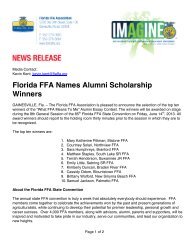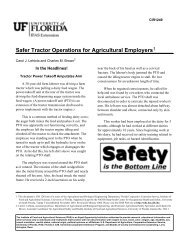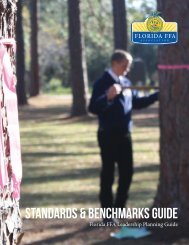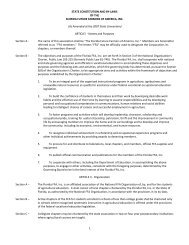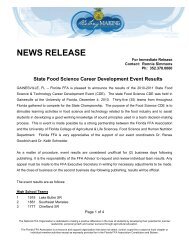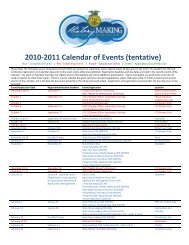CDE Handbook - Florida FFA Association
CDE Handbook - Florida FFA Association
CDE Handbook - Florida FFA Association
You also want an ePaper? Increase the reach of your titles
YUMPU automatically turns print PDFs into web optimized ePapers that Google loves.
Forestry <strong>CDE</strong><br />
78<br />
not be presented in the same visual manner in the official<br />
<strong>CDE</strong>.<br />
Event Format<br />
The contest will consist of two parts. Part 1: the General<br />
Knowledge written test will be taken by all students at one time.<br />
Part 2: will consist of field application sessions; Dendrology,<br />
Equipment Identification/Forest Disorders, and Timber<br />
Cruising will be included each year. The remaining field<br />
application session will be identified before the event. Students<br />
will rotate through each session until all have been completed.<br />
General Knowledge (100 points)<br />
1. Fifty (50) objective-type multiple-choice questions will<br />
be selected from areas of the forestry industry reflected<br />
in the contest objectives. This part of the contest will test<br />
the contestants’ knowledge and understanding of basic<br />
principles of forestry.<br />
2. Time: Each contestant will be allowed forty-five (45)<br />
minutes to complete this phase of the contest.<br />
3. Scoring: Each answer has a value of two (2) points for a<br />
total maximum score of 100 points.<br />
4. Management – may be added at state level<br />
5. This section will include a forest business management<br />
problem to determine the contestant’s ability to apply<br />
economic principles and concepts of management to the<br />
decision making process by actual problem analysis and<br />
to defend the decisions made. This will involve a model<br />
forest operation with possible calculation on profit/loss,<br />
cost of operation, taxes, depreciation, marketing product,<br />
stumpage cost, record keeping, etc. The exact problem may<br />
or may not be in a listed reference.<br />
6. Current Forestry and Timber Stand improvement issues<br />
may be included on the <strong>Florida</strong> Division of Forestry<br />
website.<br />
Dendrology (100 points)<br />
1. Twenty (20) specimens from the following list will be<br />
displayed for contestants to identify by common names.<br />
Each specimen will be designated by a number. Specimens<br />
may include cut samples, potted samples, or standing trees<br />
located within 50 feet of the Dendrology site.<br />
2. Time: Each contestant will be allowed thirty (30) minutes<br />
to complete this session.<br />
3. Scoring: Five (5) points will be given for each specimen<br />
that is correctly identified for a maximum of one-hundred<br />
(100) points.<br />
4. Approved Dendrology list:<br />
<strong>Florida</strong> <strong>FFA</strong> Career Development Event <strong>Handbook</strong><br />
American Beech – Fagus grandifolia<br />
American Elm – Ulmus americana<br />
American Holly – Illex opaca<br />
Bald Cypress – Taxodium distichum<br />
Black Cherry – Prunus serotina<br />
Carolina Ash – Fraxinus caroliniana<br />
Common Persimmon – Diospyros virginiana<br />
Eastern Hophornbeam – Ostrya virginiana<br />
American Hornbeam – Carpinus caroliniana<br />
Eastern Redbud – Cercis canadensis<br />
Flowering Dogwood – Cornus florida<br />
Laurel Oak – Quercus laurifolia<br />
Live Oak – Quercus virginiana<br />
Loblolly Bay – Gordonia lasianthus<br />
Loblolly Pine – Pinus taeda<br />
Longleaf Pine – Pinus palustris<br />
Mockernut Hickory – Carya tomentosa<br />
Pignut Hickory – Carya glabra<br />
Post Oak – Quercus stellata<br />
Red Maple – Acer rubrum<br />
Red Mulberry – Morus rubra<br />
Sand Pine – Pinus clausa<br />
Sassafras – Sassafras albidum<br />
Shumard Oak – Quercus shumardii<br />
Slash Pine – Pinus elliottii<br />
Southern Catalpa – Catalpa bignonioides<br />
Southern Magnolia – Magnolia grandiflora<br />
Southern Redcedar – Juniperus solicicola<br />
Sugarberry – Celtis laevigata<br />
Swamp Tupelo – Nyssa sylvatica var. biflora<br />
Sweetbay – Magnolia virginiana<br />
Sweetgum – Liquidambar styraciflua<br />
Sycamore – Platanus occidentalis<br />
Turkey Oak – Quercus laevis<br />
Water Hickory – Carya aquatica<br />
Water Oak – Quercus nigra<br />
Waxmyrtle – Myrica cerifera<br />
White Oak – Quercus alba<br />
Winged Elm – Ulmus alata<br />
Yellow Poplar – Liriodendron tulipifera<br />
Additional Trees for the State Contest:<br />
41. Black Walnut – Juglans nigra<br />
42. Carolina Laurelcherry – Prunus caroliniana<br />
43. Eastern Cottonwood – Populus deltoids<br />
44. <strong>Florida</strong> Maple – Acer floridanum<br />
45. Gum Bumelia – Bumelia lanuginosa<br />
46. Gumbo Limbo – Bursera simaruba



